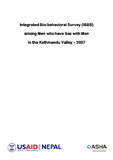Please use this identifier to cite or link to this item:
https://hdl.handle.net/20.500.14356/705Full metadata record
| DC Field | Value | Language |
|---|---|---|
| dc.contributor.author | USAID/Nepal | |
| dc.contributor.author | OASHA | |
| dc.date.accessioned | 2013-02-21T20:12:58Z | |
| dc.date.accessioned | 2022-11-08T10:18:42Z | - |
| dc.date.available | 2013-02-21T20:12:58Z | |
| dc.date.available | 2022-11-08T10:18:42Z | - |
| dc.date.issued | 2008 | |
| dc.identifier.uri | http://103.69.126.140:8080/handle/20.500.14356/705 | - |
| dc.description.abstract | EXECUTIVE SUMMARY: The National Center for AIDS and STD Control (NCASC) has developed a comprehensive National Surveillance Plan for HIV and AIDS that includes conducting Integrated Bio-Behavioral Surveys (IBBS) among the most at risk populations (MARPs) at regular intervals. These surveillance studies are aimed at assessing health risk behaviors and measuring the prevalence of HIV and Sexually Transmitted Infections (STIs) among MARPs as well as monitoring epidemic trends to inform the HIV response in Nepal. The IBBS is conducted by NCASC with technical and financial support from Family Health International/Nepal and the United States Agency for International Development (USAID). The MARPs on which the current IBBS focuses are injecting drug users (IDUs), female sex workers (FSWs), clients of FSWs, migrant workers and men who have sex with men (MSM). This report documents the findings of the second round of IBBS conducted among 400 MSM in the Kathmandu Valley. The primary objective of the study was to collect strategic information to analyze trends in risk behavior and HIV/STI prevalence rates among MSM. It is a challenging task to collect information from MARPs These groups are highly stigmatized and potential respondents are often reluctant to come forward and take part in research studies. Innovative sampling methods are needed in order to reach these individuals. Respondent Driven Sampling (RDS) methodology offers one of the most effective methods to date. RDS is a relatively new adaptation of chain referral sampling where subsequent respondents are recruited by previous respondents through their network of acquaintances. The RDS methodology was used in this study and 400 respondents were successfully recruited. In the first stage, a list of MSM cruising sites was prepared for the sampling design. In the second stage, a structured questionnaire was administered to respondents at centrally located clinics. The questionnaire collected information on sexual behavior and HIV/AIDS awareness as well as socio demographics of the respondents. The interview was followed by a clinical examination administered by a Health Assistant and involved the collection of blood, urine and swabsamples for biological testing of HIV, Syphilis, Chlamydia Trachomatis (CT) and Neisseria Gonorrhoea (NG). Study centers with laboratories/clinics were set up at two easily accessible locations at Jamal and Gaushala in the Kathmandu Valley. Samples were collected only after a pre-testcounseling session. Study participants were provided syndromic treatment for STI related problems after being examined by a health assistant and HIV and syphilis test results were provided later at Cruiseaids, Parichaya Samaj and SACTS VCT centers along with post test counseling delivered by experienced counselors. | en_US |
| dc.language.iso | en_US | en_US |
| dc.subject | Integrated Bio-behavioral Survey (IBBS) among Men who have Sex with Men in the Kathmandu Valley –2007 | en_US |
| dc.title | Integrated Bio-behavioral Survey (IBBS) among Men who have Sex with Men in the Kathmandu Valley –2007 | en_US |
| dc.type | Technical Report | en_US |
| Appears in Collections: | Post Graduate Grant (PG) Reports | |
Files in This Item:
| File | Description | Size | Format | |
|---|---|---|---|---|
| Full Report_IBBS MSM 2007 Final.pdf | Full Report. Download | 1.32 MB | Adobe PDF |  View/Open |
Items in DSpace are protected by copyright, with all rights reserved, unless otherwise indicated.
